Art Movements: Cubism Analysis Essay for Art History 1 Course
VerifiedAdded on 2022/08/29
|9
|1245
|21
Essay
AI Summary
This essay provides a comprehensive analysis of the Cubism art movement, a pivotal development in modern art that emerged in the early 20th century. The essay begins by outlining the historical context and significance of Cubism, emphasizing the contributions of Pablo Picasso and Georges Braque as its primary innovators. It then delves into the key characteristics of Cubism, such as the fragmentation of objects, multiple perspectives, and the use of geometric forms, while highlighting the influences of non-western art and Primitivism. The essay examines the evolution of Cubism, including its two phases: Analytical and Synthetic Cubism, and discusses the significance of key artworks like Picasso's "Les Demoiselles d'Avignon" and "Portrait of Olga in an Armchair" and Braque's "Houses at L’Estaque" and "Violin and Palette." The essay concludes by assessing the impact of Cubism on subsequent art movements and its lasting legacy in the history of art. The essay uses APA format and includes cited references.
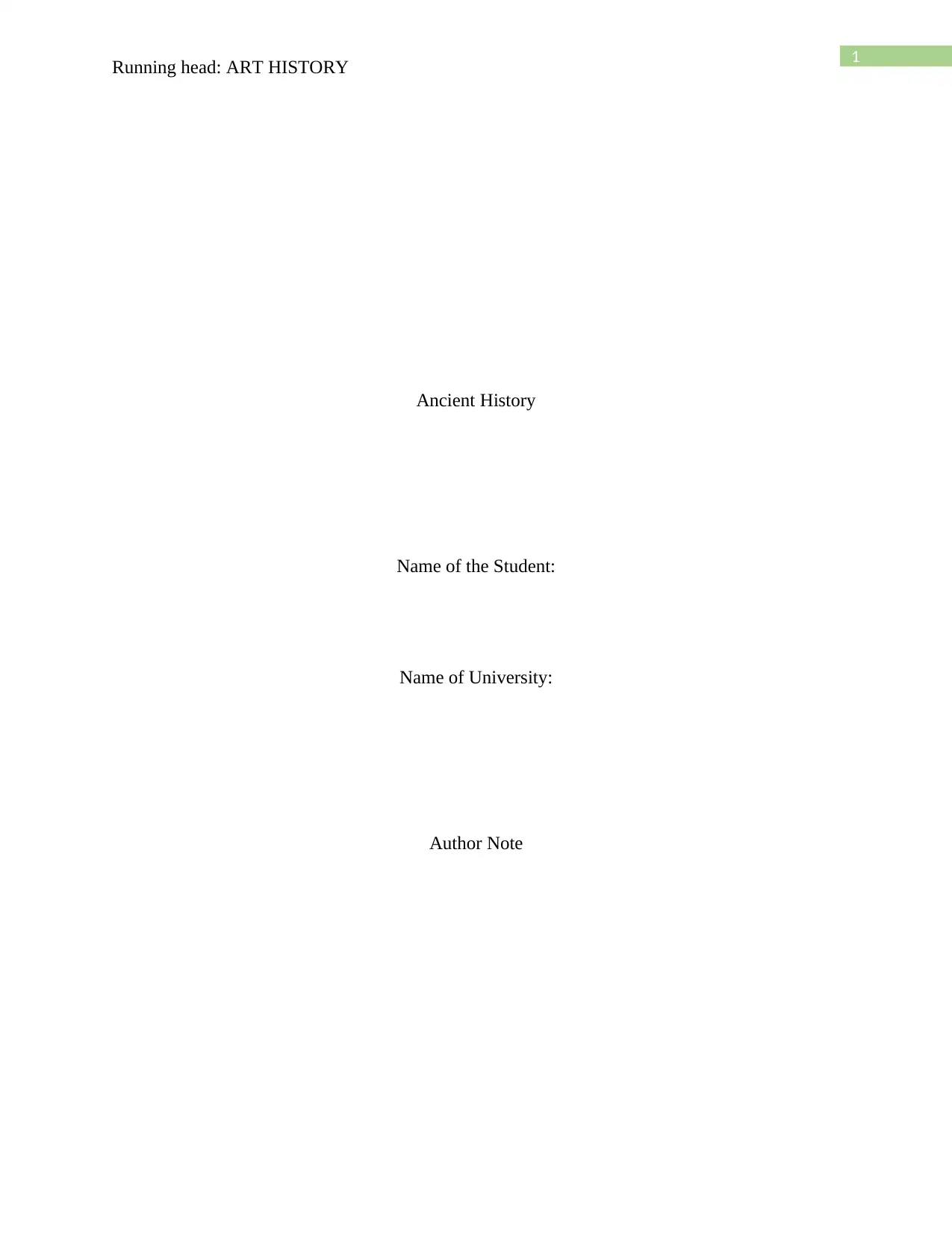
1
Running head: ART HISTORY
Ancient History
Name of the Student:
Name of University:
Author Note
Running head: ART HISTORY
Ancient History
Name of the Student:
Name of University:
Author Note
Paraphrase This Document
Need a fresh take? Get an instant paraphrase of this document with our AI Paraphraser
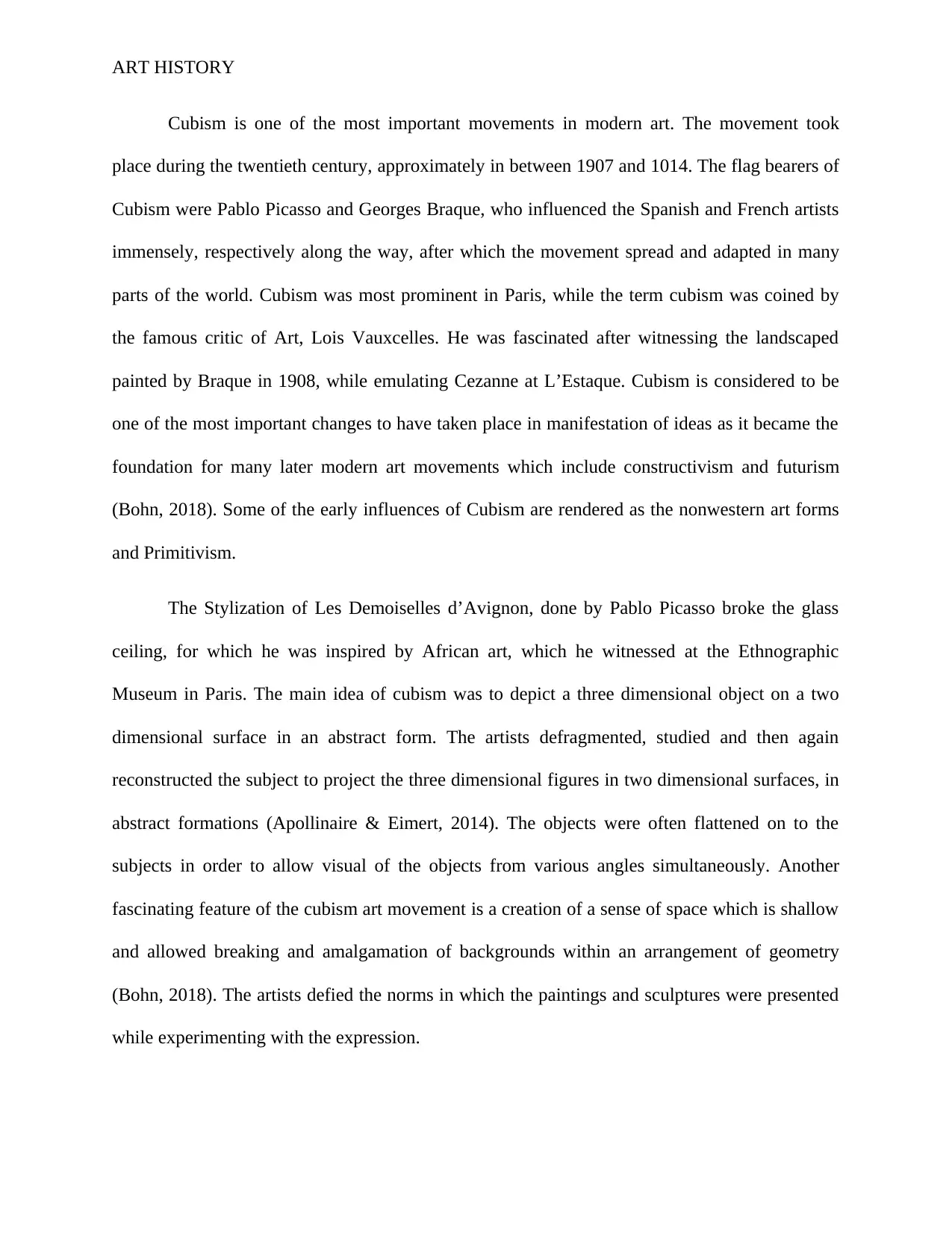
ART HISTORY
Cubism is one of the most important movements in modern art. The movement took
place during the twentieth century, approximately in between 1907 and 1014. The flag bearers of
Cubism were Pablo Picasso and Georges Braque, who influenced the Spanish and French artists
immensely, respectively along the way, after which the movement spread and adapted in many
parts of the world. Cubism was most prominent in Paris, while the term cubism was coined by
the famous critic of Art, Lois Vauxcelles. He was fascinated after witnessing the landscaped
painted by Braque in 1908, while emulating Cezanne at L’Estaque. Cubism is considered to be
one of the most important changes to have taken place in manifestation of ideas as it became the
foundation for many later modern art movements which include constructivism and futurism
(Bohn, 2018). Some of the early influences of Cubism are rendered as the nonwestern art forms
and Primitivism.
The Stylization of Les Demoiselles d’Avignon, done by Pablo Picasso broke the glass
ceiling, for which he was inspired by African art, which he witnessed at the Ethnographic
Museum in Paris. The main idea of cubism was to depict a three dimensional object on a two
dimensional surface in an abstract form. The artists defragmented, studied and then again
reconstructed the subject to project the three dimensional figures in two dimensional surfaces, in
abstract formations (Apollinaire & Eimert, 2014). The objects were often flattened on to the
subjects in order to allow visual of the objects from various angles simultaneously. Another
fascinating feature of the cubism art movement is a creation of a sense of space which is shallow
and allowed breaking and amalgamation of backgrounds within an arrangement of geometry
(Bohn, 2018). The artists defied the norms in which the paintings and sculptures were presented
while experimenting with the expression.
Cubism is one of the most important movements in modern art. The movement took
place during the twentieth century, approximately in between 1907 and 1014. The flag bearers of
Cubism were Pablo Picasso and Georges Braque, who influenced the Spanish and French artists
immensely, respectively along the way, after which the movement spread and adapted in many
parts of the world. Cubism was most prominent in Paris, while the term cubism was coined by
the famous critic of Art, Lois Vauxcelles. He was fascinated after witnessing the landscaped
painted by Braque in 1908, while emulating Cezanne at L’Estaque. Cubism is considered to be
one of the most important changes to have taken place in manifestation of ideas as it became the
foundation for many later modern art movements which include constructivism and futurism
(Bohn, 2018). Some of the early influences of Cubism are rendered as the nonwestern art forms
and Primitivism.
The Stylization of Les Demoiselles d’Avignon, done by Pablo Picasso broke the glass
ceiling, for which he was inspired by African art, which he witnessed at the Ethnographic
Museum in Paris. The main idea of cubism was to depict a three dimensional object on a two
dimensional surface in an abstract form. The artists defragmented, studied and then again
reconstructed the subject to project the three dimensional figures in two dimensional surfaces, in
abstract formations (Apollinaire & Eimert, 2014). The objects were often flattened on to the
subjects in order to allow visual of the objects from various angles simultaneously. Another
fascinating feature of the cubism art movement is a creation of a sense of space which is shallow
and allowed breaking and amalgamation of backgrounds within an arrangement of geometry
(Bohn, 2018). The artists defied the norms in which the paintings and sculptures were presented
while experimenting with the expression.
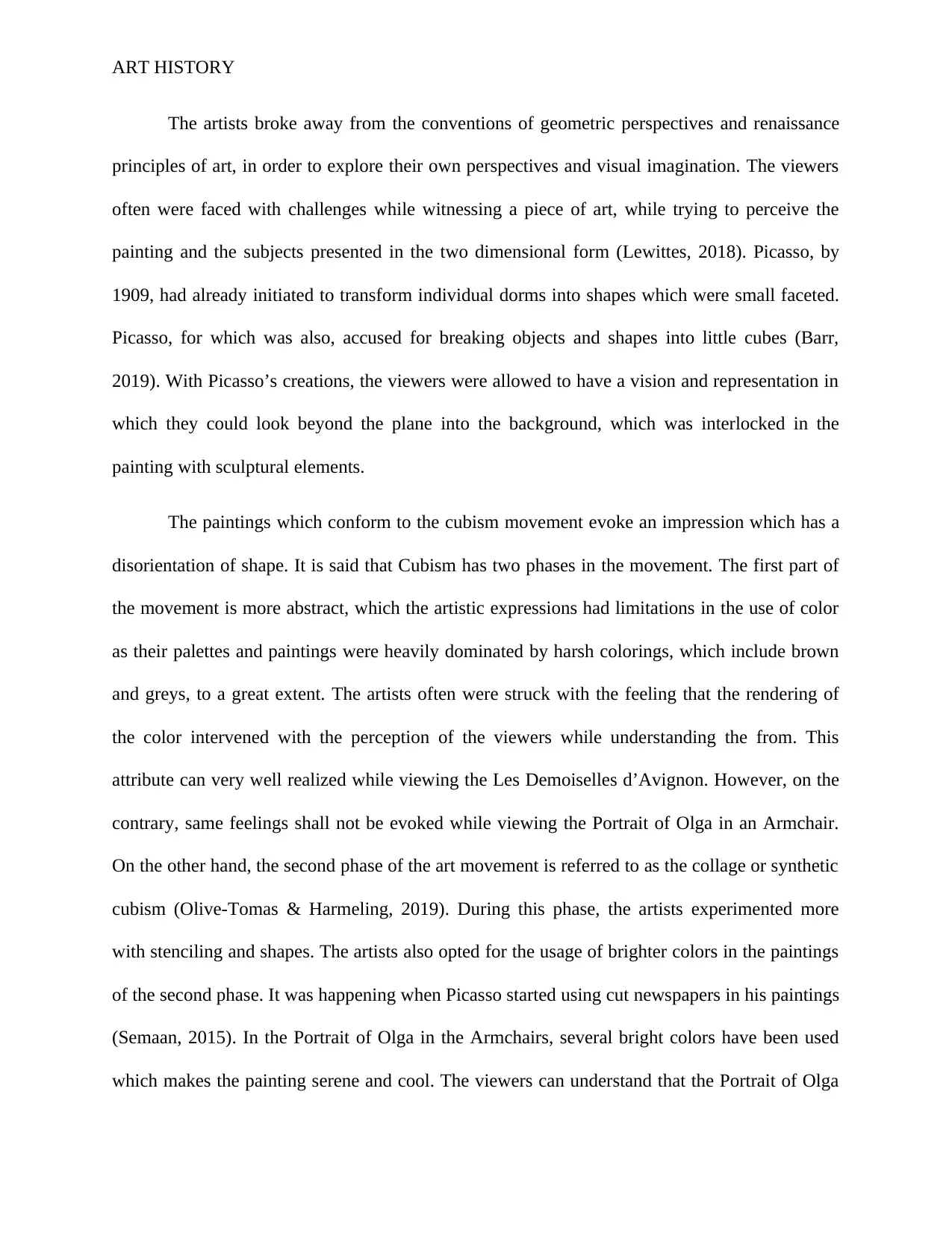
ART HISTORY
The artists broke away from the conventions of geometric perspectives and renaissance
principles of art, in order to explore their own perspectives and visual imagination. The viewers
often were faced with challenges while witnessing a piece of art, while trying to perceive the
painting and the subjects presented in the two dimensional form (Lewittes, 2018). Picasso, by
1909, had already initiated to transform individual dorms into shapes which were small faceted.
Picasso, for which was also, accused for breaking objects and shapes into little cubes (Barr,
2019). With Picasso’s creations, the viewers were allowed to have a vision and representation in
which they could look beyond the plane into the background, which was interlocked in the
painting with sculptural elements.
The paintings which conform to the cubism movement evoke an impression which has a
disorientation of shape. It is said that Cubism has two phases in the movement. The first part of
the movement is more abstract, which the artistic expressions had limitations in the use of color
as their palettes and paintings were heavily dominated by harsh colorings, which include brown
and greys, to a great extent. The artists often were struck with the feeling that the rendering of
the color intervened with the perception of the viewers while understanding the from. This
attribute can very well realized while viewing the Les Demoiselles d’Avignon. However, on the
contrary, same feelings shall not be evoked while viewing the Portrait of Olga in an Armchair.
On the other hand, the second phase of the art movement is referred to as the collage or synthetic
cubism (Olive-Tomas & Harmeling, 2019). During this phase, the artists experimented more
with stenciling and shapes. The artists also opted for the usage of brighter colors in the paintings
of the second phase. It was happening when Picasso started using cut newspapers in his paintings
(Semaan, 2015). In the Portrait of Olga in the Armchairs, several bright colors have been used
which makes the painting serene and cool. The viewers can understand that the Portrait of Olga
The artists broke away from the conventions of geometric perspectives and renaissance
principles of art, in order to explore their own perspectives and visual imagination. The viewers
often were faced with challenges while witnessing a piece of art, while trying to perceive the
painting and the subjects presented in the two dimensional form (Lewittes, 2018). Picasso, by
1909, had already initiated to transform individual dorms into shapes which were small faceted.
Picasso, for which was also, accused for breaking objects and shapes into little cubes (Barr,
2019). With Picasso’s creations, the viewers were allowed to have a vision and representation in
which they could look beyond the plane into the background, which was interlocked in the
painting with sculptural elements.
The paintings which conform to the cubism movement evoke an impression which has a
disorientation of shape. It is said that Cubism has two phases in the movement. The first part of
the movement is more abstract, which the artistic expressions had limitations in the use of color
as their palettes and paintings were heavily dominated by harsh colorings, which include brown
and greys, to a great extent. The artists often were struck with the feeling that the rendering of
the color intervened with the perception of the viewers while understanding the from. This
attribute can very well realized while viewing the Les Demoiselles d’Avignon. However, on the
contrary, same feelings shall not be evoked while viewing the Portrait of Olga in an Armchair.
On the other hand, the second phase of the art movement is referred to as the collage or synthetic
cubism (Olive-Tomas & Harmeling, 2019). During this phase, the artists experimented more
with stenciling and shapes. The artists also opted for the usage of brighter colors in the paintings
of the second phase. It was happening when Picasso started using cut newspapers in his paintings
(Semaan, 2015). In the Portrait of Olga in the Armchairs, several bright colors have been used
which makes the painting serene and cool. The viewers can understand that the Portrait of Olga
⊘ This is a preview!⊘
Do you want full access?
Subscribe today to unlock all pages.

Trusted by 1+ million students worldwide
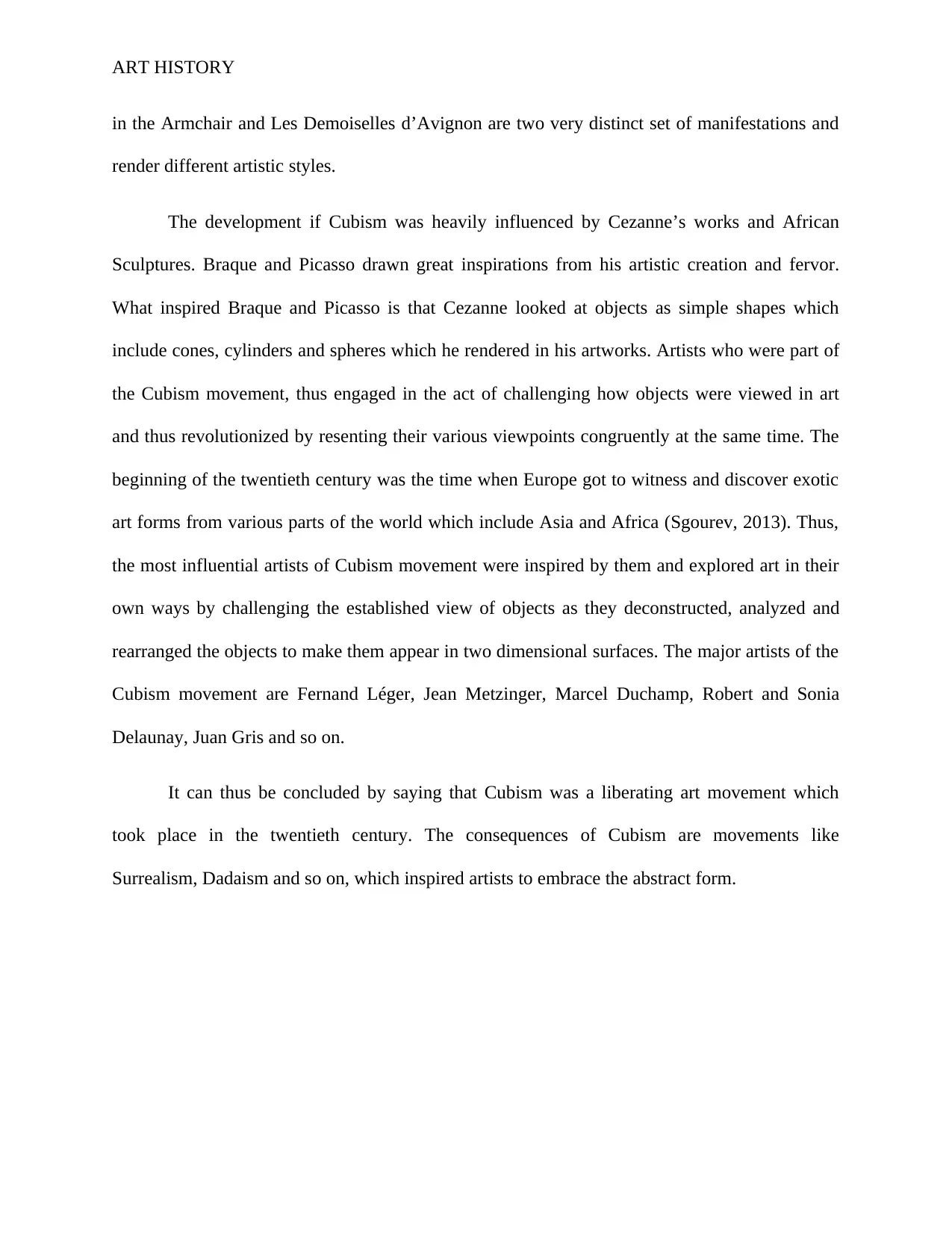
ART HISTORY
in the Armchair and Les Demoiselles d’Avignon are two very distinct set of manifestations and
render different artistic styles.
The development if Cubism was heavily influenced by Cezanne’s works and African
Sculptures. Braque and Picasso drawn great inspirations from his artistic creation and fervor.
What inspired Braque and Picasso is that Cezanne looked at objects as simple shapes which
include cones, cylinders and spheres which he rendered in his artworks. Artists who were part of
the Cubism movement, thus engaged in the act of challenging how objects were viewed in art
and thus revolutionized by resenting their various viewpoints congruently at the same time. The
beginning of the twentieth century was the time when Europe got to witness and discover exotic
art forms from various parts of the world which include Asia and Africa (Sgourev, 2013). Thus,
the most influential artists of Cubism movement were inspired by them and explored art in their
own ways by challenging the established view of objects as they deconstructed, analyzed and
rearranged the objects to make them appear in two dimensional surfaces. The major artists of the
Cubism movement are Fernand Léger, Jean Metzinger, Marcel Duchamp, Robert and Sonia
Delaunay, Juan Gris and so on.
It can thus be concluded by saying that Cubism was a liberating art movement which
took place in the twentieth century. The consequences of Cubism are movements like
Surrealism, Dadaism and so on, which inspired artists to embrace the abstract form.
in the Armchair and Les Demoiselles d’Avignon are two very distinct set of manifestations and
render different artistic styles.
The development if Cubism was heavily influenced by Cezanne’s works and African
Sculptures. Braque and Picasso drawn great inspirations from his artistic creation and fervor.
What inspired Braque and Picasso is that Cezanne looked at objects as simple shapes which
include cones, cylinders and spheres which he rendered in his artworks. Artists who were part of
the Cubism movement, thus engaged in the act of challenging how objects were viewed in art
and thus revolutionized by resenting their various viewpoints congruently at the same time. The
beginning of the twentieth century was the time when Europe got to witness and discover exotic
art forms from various parts of the world which include Asia and Africa (Sgourev, 2013). Thus,
the most influential artists of Cubism movement were inspired by them and explored art in their
own ways by challenging the established view of objects as they deconstructed, analyzed and
rearranged the objects to make them appear in two dimensional surfaces. The major artists of the
Cubism movement are Fernand Léger, Jean Metzinger, Marcel Duchamp, Robert and Sonia
Delaunay, Juan Gris and so on.
It can thus be concluded by saying that Cubism was a liberating art movement which
took place in the twentieth century. The consequences of Cubism are movements like
Surrealism, Dadaism and so on, which inspired artists to embrace the abstract form.
Paraphrase This Document
Need a fresh take? Get an instant paraphrase of this document with our AI Paraphraser
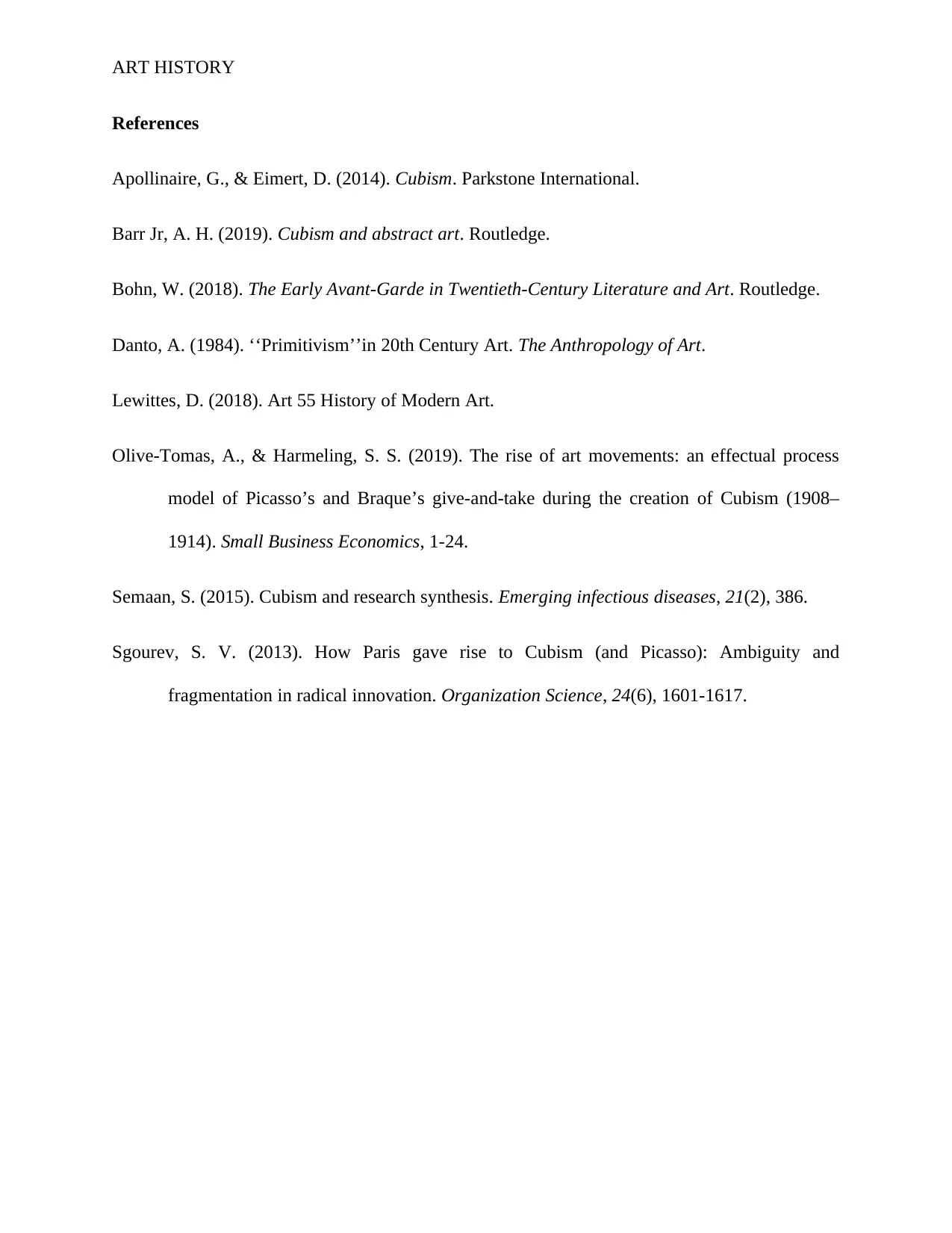
ART HISTORY
References
Apollinaire, G., & Eimert, D. (2014). Cubism. Parkstone International.
Barr Jr, A. H. (2019). Cubism and abstract art. Routledge.
Bohn, W. (2018). The Early Avant-Garde in Twentieth-Century Literature and Art. Routledge.
Danto, A. (1984). ‘‘Primitivism’’in 20th Century Art. The Anthropology of Art.
Lewittes, D. (2018). Art 55 History of Modern Art.
Olive-Tomas, A., & Harmeling, S. S. (2019). The rise of art movements: an effectual process
model of Picasso’s and Braque’s give-and-take during the creation of Cubism (1908–
1914). Small Business Economics, 1-24.
Semaan, S. (2015). Cubism and research synthesis. Emerging infectious diseases, 21(2), 386.
Sgourev, S. V. (2013). How Paris gave rise to Cubism (and Picasso): Ambiguity and
fragmentation in radical innovation. Organization Science, 24(6), 1601-1617.
References
Apollinaire, G., & Eimert, D. (2014). Cubism. Parkstone International.
Barr Jr, A. H. (2019). Cubism and abstract art. Routledge.
Bohn, W. (2018). The Early Avant-Garde in Twentieth-Century Literature and Art. Routledge.
Danto, A. (1984). ‘‘Primitivism’’in 20th Century Art. The Anthropology of Art.
Lewittes, D. (2018). Art 55 History of Modern Art.
Olive-Tomas, A., & Harmeling, S. S. (2019). The rise of art movements: an effectual process
model of Picasso’s and Braque’s give-and-take during the creation of Cubism (1908–
1914). Small Business Economics, 1-24.
Semaan, S. (2015). Cubism and research synthesis. Emerging infectious diseases, 21(2), 386.
Sgourev, S. V. (2013). How Paris gave rise to Cubism (and Picasso): Ambiguity and
fragmentation in radical innovation. Organization Science, 24(6), 1601-1617.
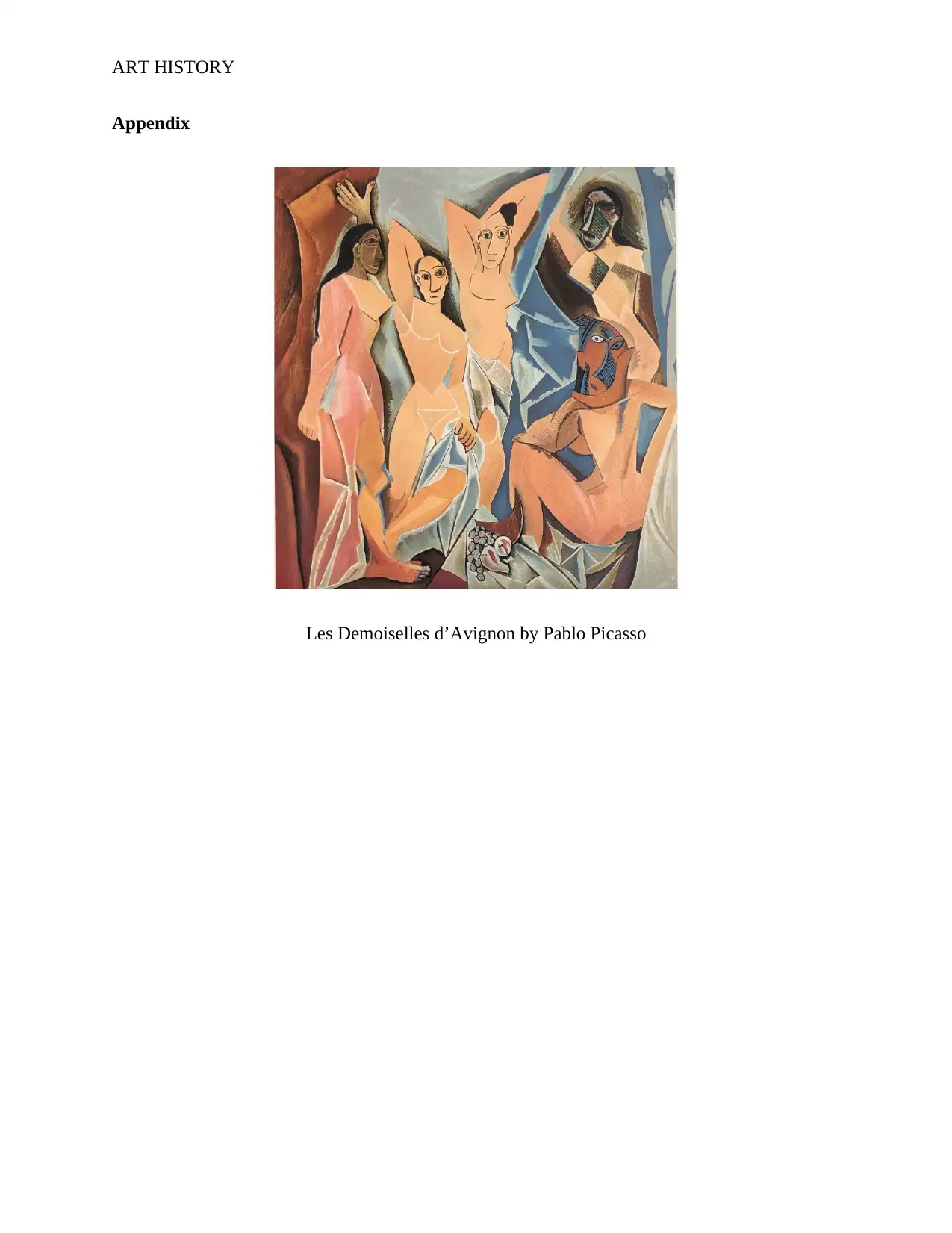
ART HISTORY
Appendix
Les Demoiselles d’Avignon by Pablo Picasso
Appendix
Les Demoiselles d’Avignon by Pablo Picasso
⊘ This is a preview!⊘
Do you want full access?
Subscribe today to unlock all pages.

Trusted by 1+ million students worldwide
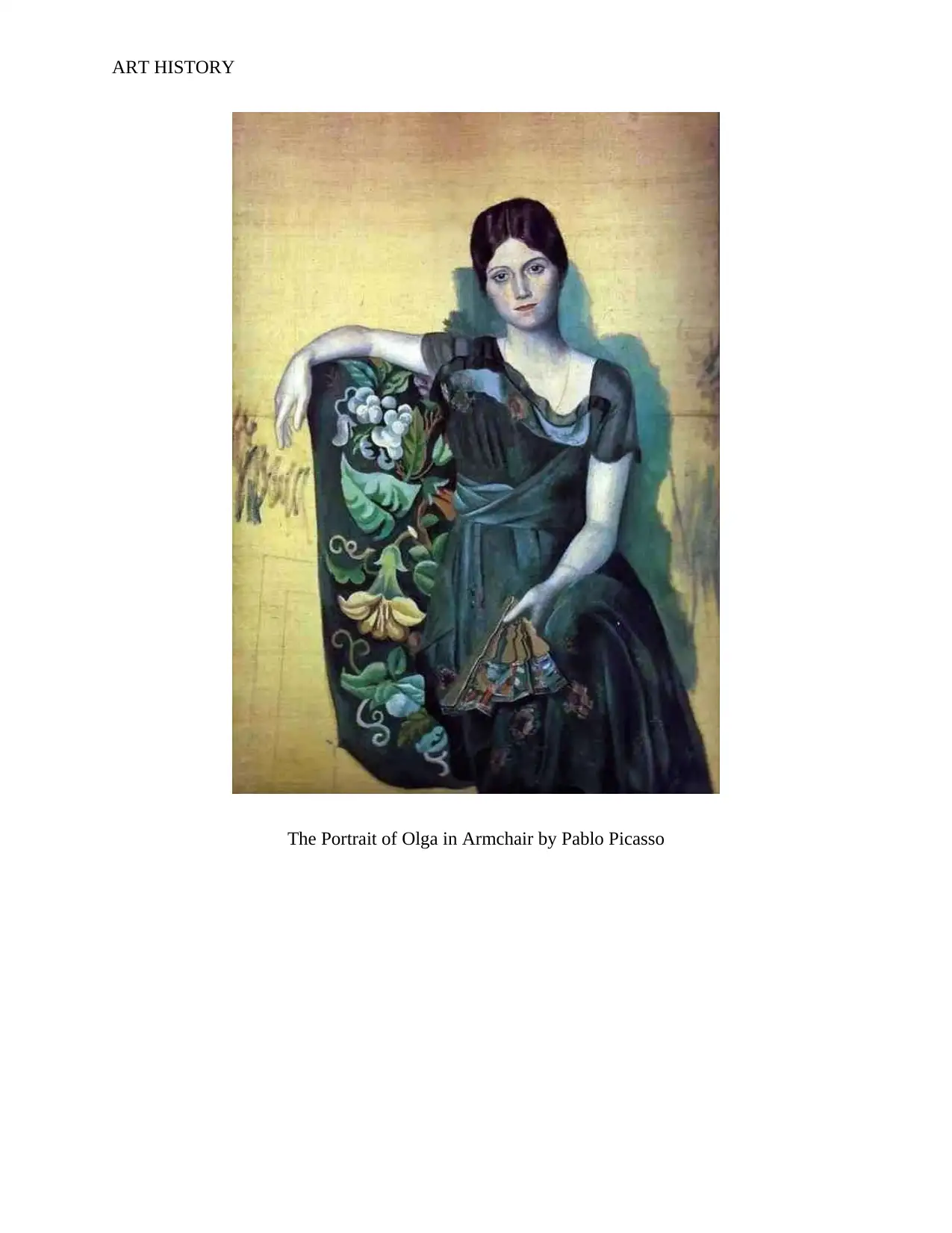
ART HISTORY
The Portrait of Olga in Armchair by Pablo Picasso
The Portrait of Olga in Armchair by Pablo Picasso
Paraphrase This Document
Need a fresh take? Get an instant paraphrase of this document with our AI Paraphraser
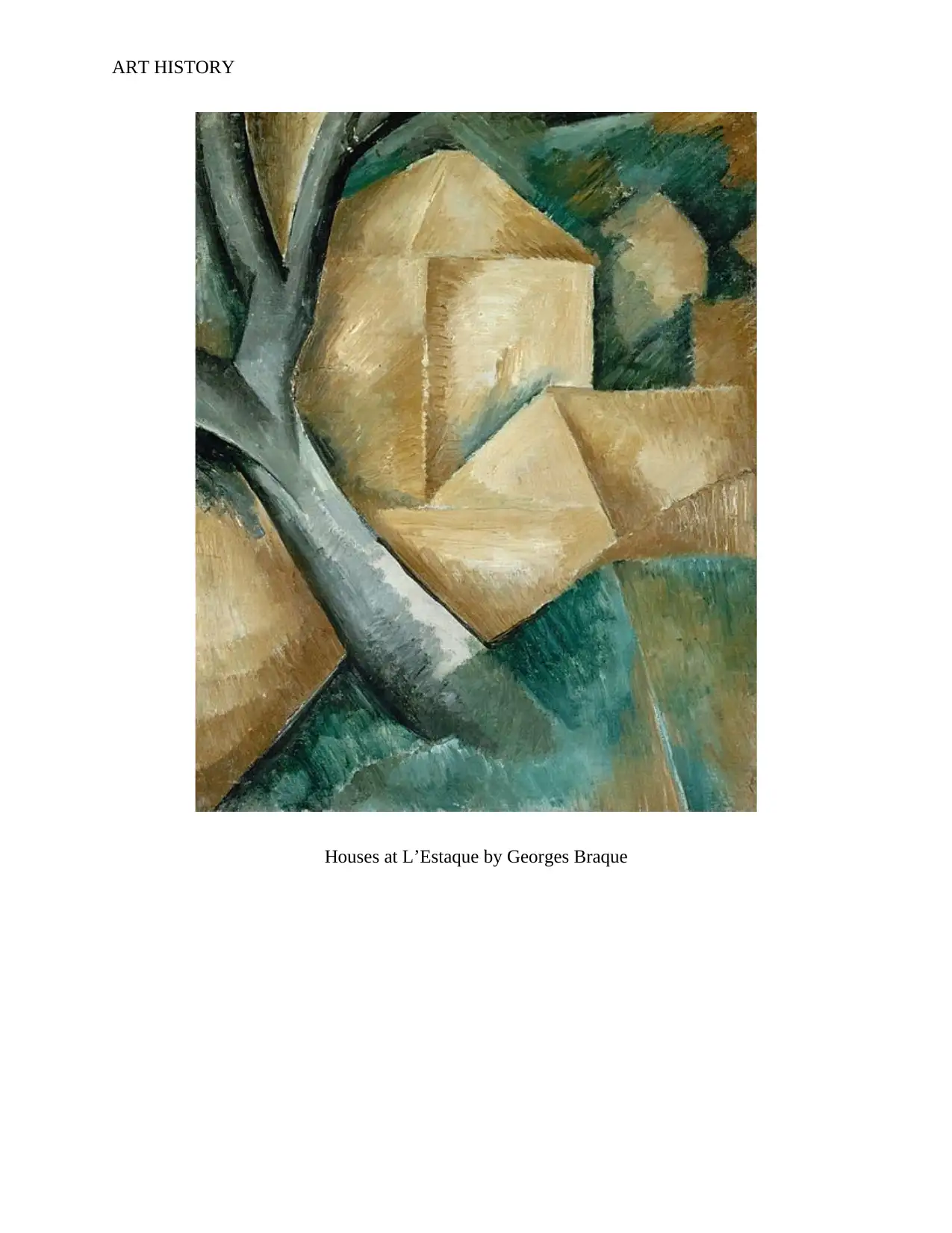
ART HISTORY
Houses at L’Estaque by Georges Braque
Houses at L’Estaque by Georges Braque
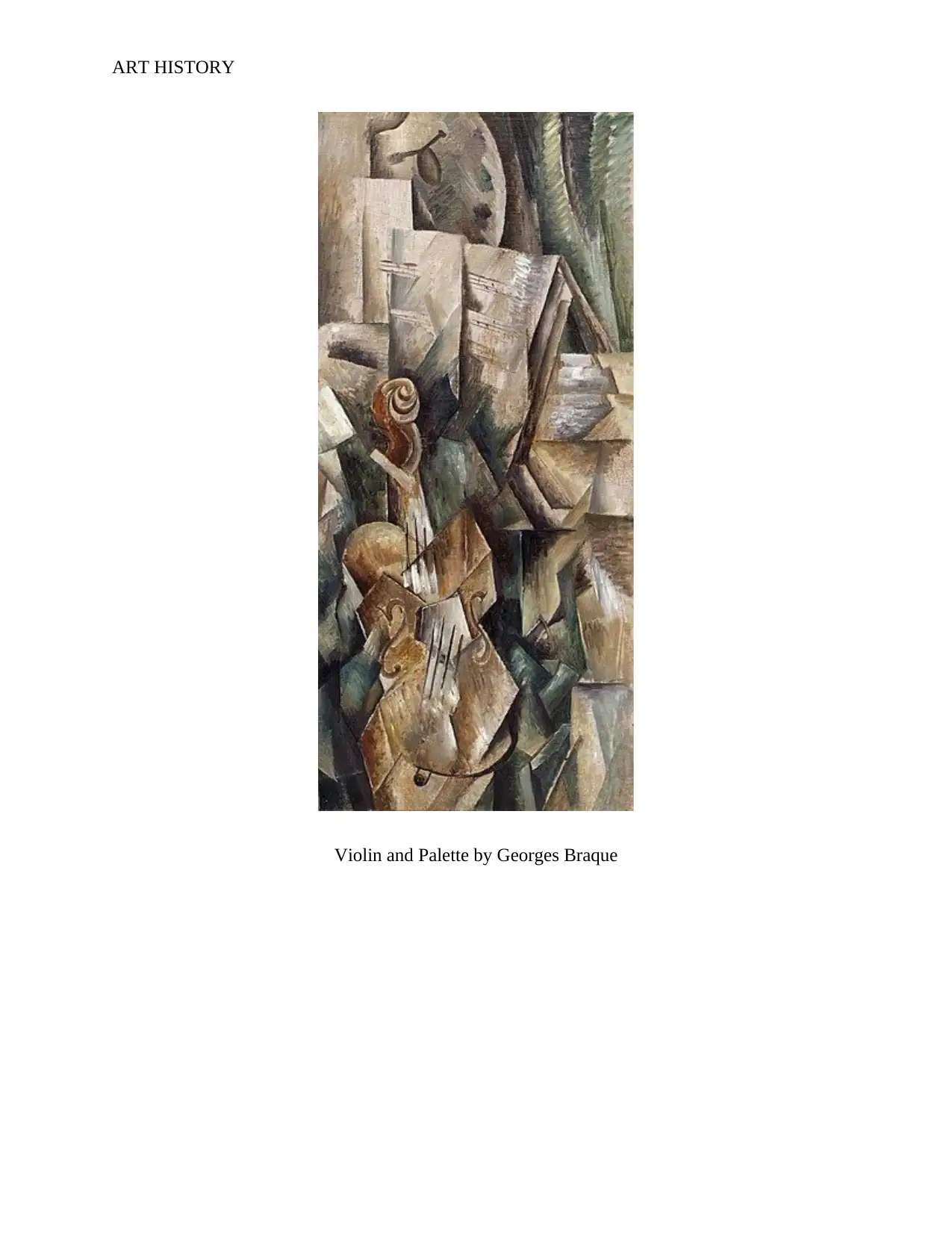
ART HISTORY
Violin and Palette by Georges Braque
Violin and Palette by Georges Braque
⊘ This is a preview!⊘
Do you want full access?
Subscribe today to unlock all pages.

Trusted by 1+ million students worldwide
1 out of 9
Related Documents
Your All-in-One AI-Powered Toolkit for Academic Success.
+13062052269
info@desklib.com
Available 24*7 on WhatsApp / Email
![[object Object]](/_next/static/media/star-bottom.7253800d.svg)
Unlock your academic potential
Copyright © 2020–2025 A2Z Services. All Rights Reserved. Developed and managed by ZUCOL.





